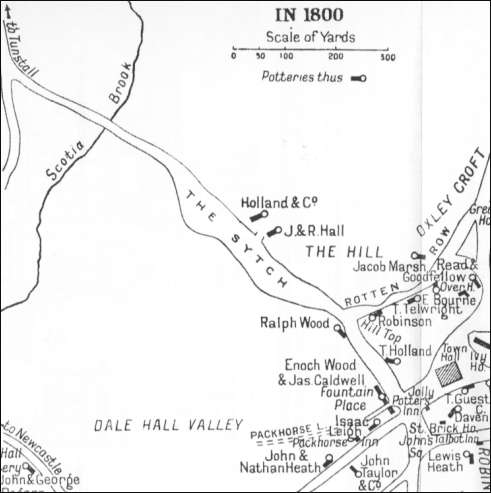![]()
|
Ralph
Wood I |
Location and period of operation:
|
Ralph
Wood
I |
Burslem |
b.1715 |
c.1772 |
|
Ralph
Wood |
Burslem |
b.1748 |
d.1795 |
|
Ralph
Wood |
Burslem |
b.1781 |
d.1801 |
| - see more on the Wood families of potters - |
|
Ralph Wood - the miller: Ralph Wood (1676-1753) "A miller of Burslem and also at Cheddleton, near Leek and at Bells Mills, Shelton". He and his wife Elizabeth Hammond had 5 girls and 4 boys. Three of their sons, Ralph, Aaron and Moses, headed up what was to become three branches of notable potters -
|
|
The "Ralph Wood" potters: "There were three generations of potters of this name; Ralph Wood the elder (born 1715 died 1772), was the son of a miller. He commenced to manufacture salt-glazed stoneware, 'Whieldon' ware, figures and toby jugs in Burslem in 1754 and built up a successful business which was continued by his son Ralph Wood II (born 1748 died 1795) and grandson Ralph Wood III (born 1781 died 1801) until 1801." Mankowitz & Haggar |
|
Ralph Wood I: (1715-72). Variously referred to as 'Ralph Wood Snr', 'Ralph Wood the elder'. "Ralph, the eldest, born in 1715, achieved renown round about 1750 with his famous and now rare Staffordshire figures and especially his delightful Toby Jugs" Married Mary, daughter of Aaron Wedgwood of Burslem. NOTE: Often this Ralph Wood is erroneously identified as "A miller of Burslem" - it was his father who was the miller.
In 1730 he was apprentice to John Astbury, and later worked with Thomas Whieldon at Fenton Low, learning the manufacture of coloured glazes. By about 1760 Ralph Wood was making extremely well-modeled figures with coloured glazes. Subjects were in great variety; the best is probably the equestrian "Hudibras" glazed in manganese and orange. The "Vicar and Moses appeared at this time and enjoyed great popularity. Wood was among the first of English potters to impress his name on his wares (Specimens made by the Woods, father and son, are sometimes impressed with a name, R. WOOD or R. WOOD BURSLEM). He is credited with introducing the Toby jug, his first model of the kind being "Toby Philpot" about 1762.
Ralph Wood model - Hudibras on horse, circa 1770-1790 Hudibras is an English mock-heroic narrative poem written by Samuel Butler. source acknowledgement: Bonhams sale record July 2013
|
|
Ralph Wood II: (1748-95). Variously referred to as 'Ralph Wood Jnr', 'Ralph Wood the younger'. He was the brother of Josiah Wood. Ralph Wood II produced many figures, both from his father's moulds and from new ones of a variety of subjects. His figures were coloured with enamels instead of glazes, and many were impressed with the mold number in the base. An extant invoice shows him supplying figures to Josiah Wedgwood in 1783. |
|
Ralph Wood III: (1781-1801). He continued the Hill Potworks until his early death in 1801, at which time production of Ralph Wood figures ceased. It is not clear if he modelled himself, or even introduced new figures. Wikipedia |

1800 map which shows the works of Ralph Wood
III at the location of the Hill Works
|
This area of Burslem was known as 'The Sytch'. From around 1750 Ralph Wood I had been making at this location - the business closed in 1801 on the death of Ralph Wood III. In 1814 the works were rebuilt by John & Richard Riley. |
- see
information on the later Hill Works -
| - see more on the Wood families of potters - |
Questions, Comments, contributions? email: Steve Birks